Advanced Air Mobility

About This Trend
Advanced air mobility (AAM) is an emerging transportation sector using vertical take-off and landing (VTOL) vehicles, the market for which is projected to reach $41.5 billion USD by 2035. Several companies, including Alef Aeronautics, Archer, Volocopter, and Joby Aviation, have received FAA exemptions to operate in U.S. airspace for research and development, with some piloting test flights in different cities. The first autonomous intercity eVTOL flight was completed in China in early 2024, and in October 2024, the FAA announced regulations allowing "powered-lift" aircraft to operate within the National Airspace System. This technology has also attracted the interest of airline companies, which are partnering with eVTOL companies to establish routes between airports and downtowns.
Despite these advancements, however, many of the promises of AAM companies have been slow to arrive. Places such as Houston, San Francisco, Dubai, and France have signed service agreements with AAM companies, though operation dates have been continuously delayed. Critical to the success of AAM is the construction of vertiports — hubs for eVTOLs — and companies are already negotiating deals for their development in the UK and Australia, with the FAA also releasing vertiport design standards. Integrating these structures into existing environments may pose a challenge, however, given the number that will be required. Planners should monitor developments within the AAM space as the growth of this sector may affect traditional ground transportation systems.
Trend Category:
Transportation and Infrastructure
Timeframe: Prepare
As Seen in APA's Trend Report
Related Publications
Related Trends




